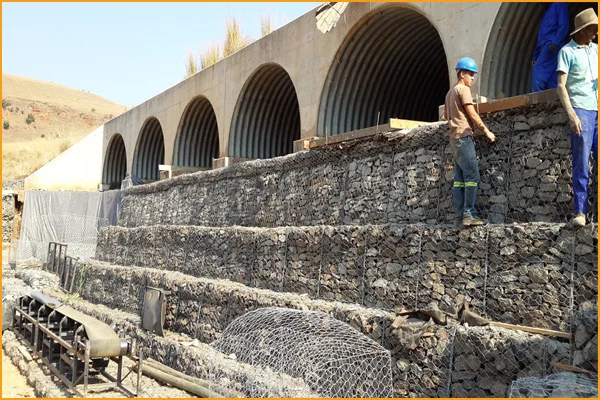Table Of Content

Angular rocks are usually the best fill material for gabion walls because they lock together and make a non-moving unit. Ultimately, it’s up to you if you would rather have your gabion retaining wall be more traditional or curved in nature. That being said, if you want to hire someone to do the project, you’ll need to make sure they’re skilled in warping the mesh before agreeing to let them do the job.
Decorative Elements
On the other hand, Gabion walls tend to have a very modern, very industrial feel to them. While this isn’t necessarily a bad thing, you have to be sure that’s the kind of look you’re going for. Gabion walls become reinforced as dirt and other organic matter fills the gaps between the cage and the rocks. Gabion walls move with the earth as it shifts, without reducing the protection they give. The design of the drainage system is just as important as the design of the retaining wall.
Case Studies: Inspiring Projects
Gabion gravity retaining walls are typically placed directly on a graded soil foundation. A 10m tall gabion retaining wall is to be constructed to create a change in elevation between two residential buildings. The water table has been found to be below the level of the base to the retaining wall and there is a surcharge of 10 kN/m2 applied on the backfill.
ASLA 2012 Professional Awards Arizona State University Polytechnic Campus — New Academic Complex - American Society of Landscape Architects
ASLA 2012 Professional Awards Arizona State University Polytechnic Campus — New Academic Complex.
Posted: Sun, 29 Nov 2015 04:47:22 GMT [source]
What is the tolerance for compression test results of concrete, according to the standards?
In commercial projects, gabion walls can be employed for highway and railway stabilization, erosion control in waterways, and noise barrier construction. Integrating gabion retaining walls into sustainable landscaping practices can further enhance their environmental benefits. This includes implementing water-saving irrigation systems, using organic fertilizers, and selecting drought-tolerant plant species. By adopting these practices, you can create a green and sustainable landscape that complements the gabion walls. In this case study, we examine a residential garden that underwent a stunning transformation with the addition of a gabion retaining wall.
Commercial Erosion Control Solution
They’re also relatively straightforward to build on your own—even if you’re a beginner. Over time, water, settling, or other factors will cause standard brick, stone, or concrete retaining walls to crack. Meanwhile, gabion walls are built without a solid base, instead using flexible wire baskets. This design prevents the wall from cracking and keeps the structure flexible—yet sturdy.
Rock Filling
If you’re looking for something a little more natural, it may be best to steer away from a gabion retaining wall. Or, if you’re willing to wait, you can see what kind of vegetation begins to grow in the cracks of the rocks in your gabion wall. This is because we can assemble the mesh and rocks easier if we lay them straight rather than on a curve.
Obviously, they’re used for outdoor landscaping, but we can utilize them in various ways. Gabion walls are impressive for retention but can also be used as seating walls, accent walls, or decorative walls to add an extra flair to your outdoor area. By integrating native plant species within the wall, you can create habitats for various animals and insects. This enhances the ecological value of the landscape and contributes to the overall health of the ecosystem. Building a gabion wall is relatively simple, especially when compared with the task of building a retaining wall using stone, brick, or concrete.
Volcanic stone gabions support meditation platform at Utah spiritual retreat - Dezeen
Volcanic stone gabions support meditation platform at Utah spiritual retreat.
Posted: Mon, 15 Aug 2016 07:00:00 GMT [source]
An important point to make when building a gabion wall in a cold climate – be sure to use non-porous stones that don’t absorb water and then freeze and crack in the winter. Wood wall materials can be cost-effective, but some types will raise the cost significantly. Not only are they beneficial for the earth, but they’re also aesthetically pleasing and can be great accent pieces for your garden or any other outdoor area in your home. Since mesh openings are generally 75mm square holes, the rocks or infill materials are usually selected to have a nominal diameter of 75 – 200mm.
What is a Gabion Wall and How Do You Use It in Your Home Landscape?
The term “gabion” comes from the Italian word “gabbione,” meaning “cage.” They make gabion retaining walls out of wire mesh formed into boxes or baskets and then fill them with rock or stone. These retaining walls help prevent erosion and also stabilize any steep slopes you may have. Integrating water features into gabion retaining walls can create a soothing and tranquil ambiance. Waterfalls, cascades, or small fountains can be incorporated into the wall design, adding a sense of movement and serenity.
Gabion walls with a stepped front face shall have a minimum 1’-1.5’ horizontal setback for each 3’ vertical lift. Just crunching the numbers alone shows how cost-efficient building a gabion wall can be. If you don’t want to pay anyone for labor, it’s also extremely easy to figure out how to build and install the wall yourself. So not only do you save money, but you can remember the effort that went into your backyard space. They’re great for preserving the land on civil projects that may include construction inside the retaining wall but need to preserve the surrounding area’s earth. They can also make impressive additions to gardens, outdoor seating areas or just make great dividers for whatever space you need them for.
When building gabions on softer soils, both the depth of the toe and the size of the base needs to be increased to spread the load over a wider area. An engineer’s design will consider design limit states and specify the dimensions of the toe and base for your wall. Like we mentioned before, though, these walls tend to be very industrial and modern in nature.

Gabion walls have easy installation, so even those unskilled in crafting can make, fill, and close the wire baskets. In fact, these retention walls don’t even need a foundation because once they’re filled with rocks, they weigh so much that they anchor themselves down. The hard work really comes into play when filling the baskets with the stones or other material(s) you select. This task will take some time and won’t be easy on your muscles and joints, especially if you’re filling the baskets by hand or with a shovel. Also, keep in mind that if you plan to build a tall gabion wall, it can be more complicated to fill the upper layers of baskets. If you’re building your own gabion wall, be prepared to put in a fair amount of physical labor.
Installation is simple and affordable, as even unskilled laborers can install gabion walls. In gravity retaining walls, the geometry of the wall must be such that it prevents any tension been generated within it. Therefore, with respect to pressure, the gabion wall geometry must be checked to ensure that eccentricity of the resultant of the pressure is within the middle third of the base. The labor costs for constructing a gabion retaining wall will depend on the size of the project, the complexity of the design, and the local labor rates.

No comments:
Post a Comment